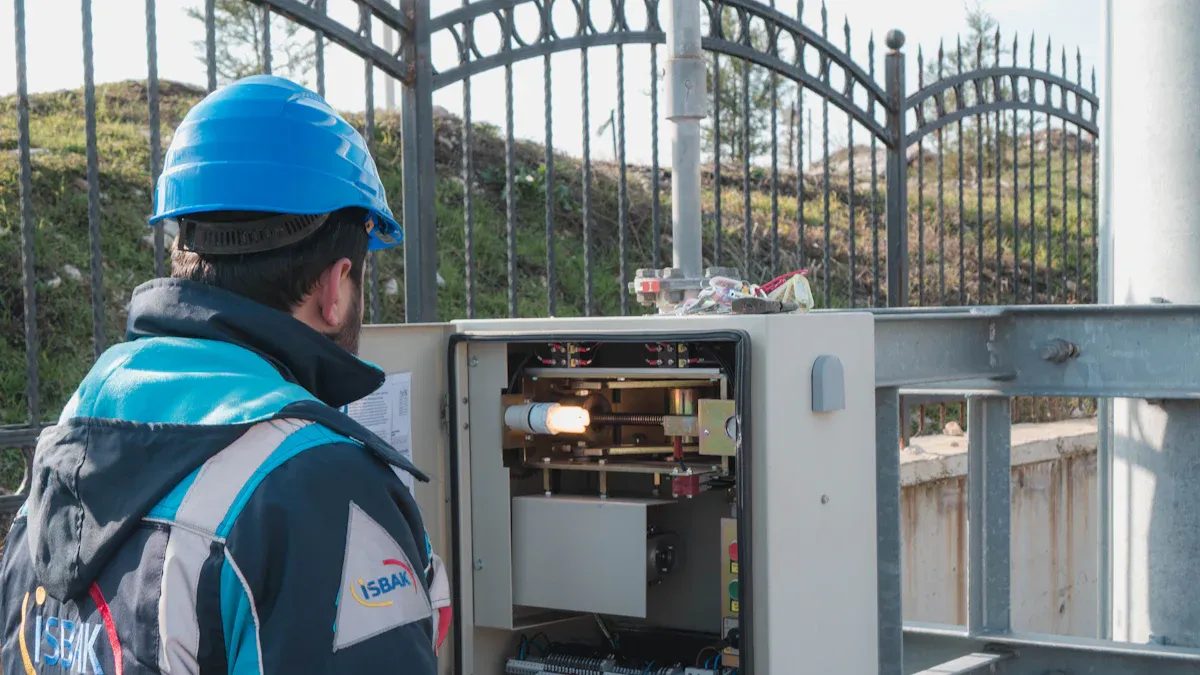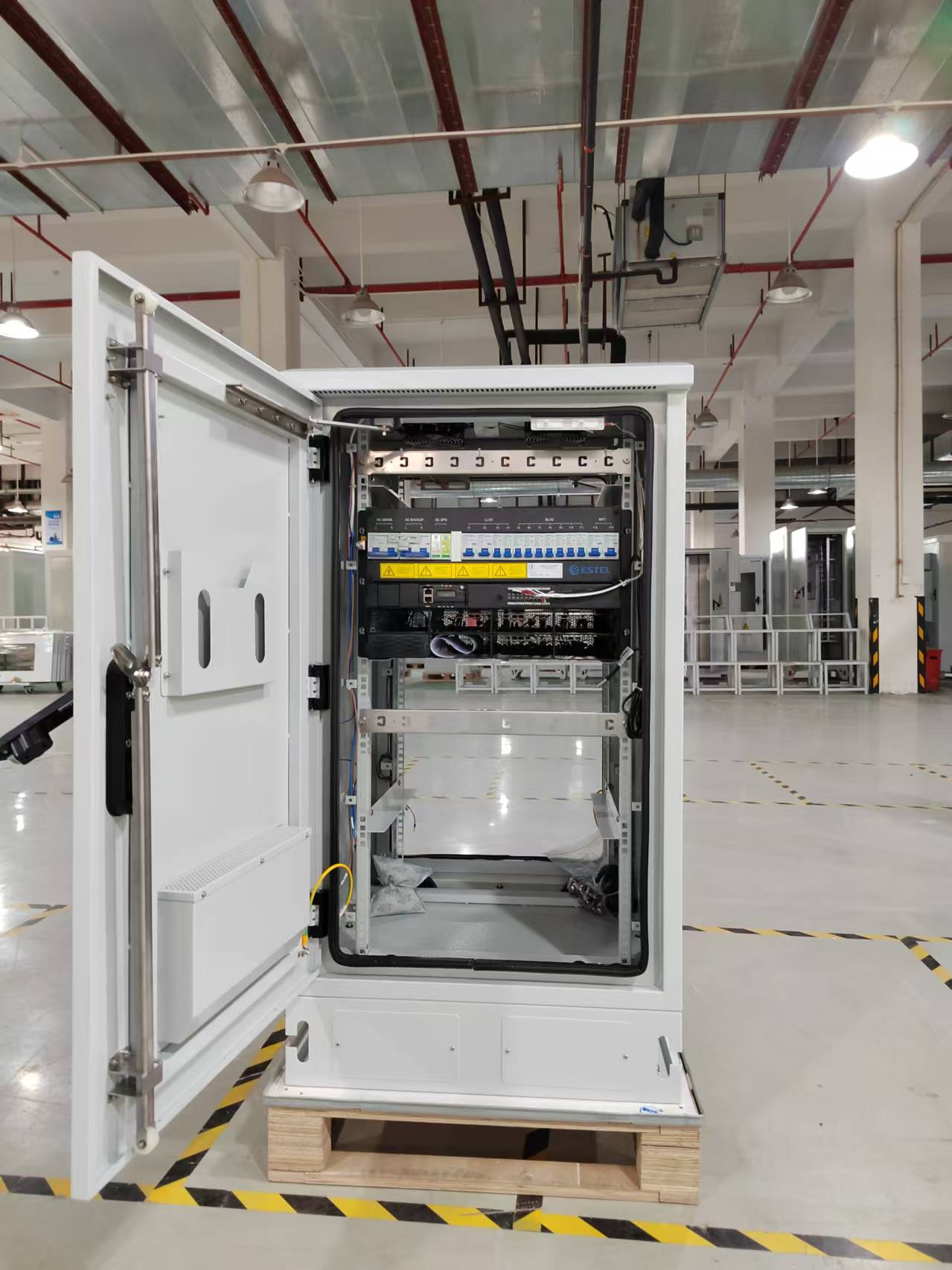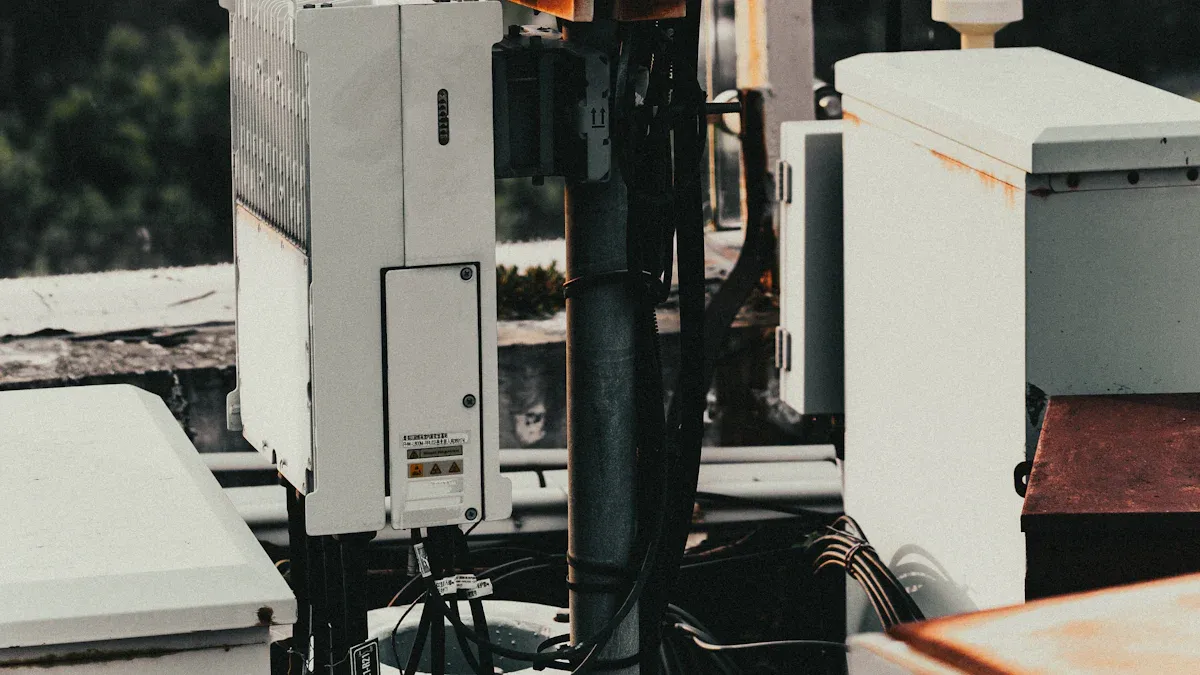How to Maintain ESTEL Telecom Rectifier Cabinets for Long-Term Efficiency

Telecom rectifier cabinets serve as the backbone of telecom network equipment repair by providing reliable and efficient power conversion. With over 500,000 systems deployed globally and 2,400,000 rectifier modules in operation, their role is indispensable. These modules already achieve near 97% efficiency, with a goal to reach 98%, showcasing their critical importance in modern networks.
Proactive maintenance ensures these cabinets operate at peak performance. Monitoring voltage uncovers electrical issues early, while temperature tracking prevents overheating. Regular checks on power output maintain optimal system functionality. This approach reduces downtime, improves service quality, and saves costs, ultimately enhancing the reputation of service providers.
Key Takeaways
Clean telecom rectifier cabinets often to stop dust buildup. Dust can make them overheat and work less efficiently. Clean during quiet times to avoid interruptions.
Check cables and connections regularly for damage or wear. Fix loose connections and replace broken cables to keep power steady and working well.
Watch voltage, current, and temperature closely to catch problems early. Use tools to check these numbers and set alerts for unusual changes.
Create a regular plan for maintenance checks and tests. Doing this often helps find issues early, saving time and money on repairs.
Use parts approved by the maker for fixing to keep the warranty. Follow instructions to avoid changes that could hurt how it works.
Routine Maintenance for Telecom Rectifier Cabinets

Cleaning and Dust Removal
Keeping your telecom rectifier cabinet clean is essential for maintaining its efficiency. Dust and debris can accumulate over time, blocking ventilation and causing components to overheat. You should regularly clean the cabinet's exterior and interior to prevent these issues. Use a soft, lint-free cloth or an anti-static brush to remove dust from sensitive areas. Avoid using water or harsh chemicals, as they can damage the rectifier modules.
Pay special attention to the cooling fans and air filters. Clogged filters reduce airflow, leading to overheating and reduced performance. Replace or clean these filters as part of your routine rectifier module maintenance. A clean cabinet not only ensures optimal performance but also extends the lifespan of the equipment.
Tip: Schedule cleaning during low-traffic periods to minimize service disruptions.
Inspecting Connections and Cables
Loose or damaged connections can disrupt the performance of your telecom rectifier cabinet. Regularly inspect all cables and connectors for signs of wear, corrosion, or fraying. Tighten any loose connections and replace damaged cables immediately to avoid power interruptions.
When inspecting, focus on the input and output terminals of the rectifier. Ensure that all connections are secure and free from oxidation. Use a multimeter to test the continuity of cables and verify that they are functioning correctly. This proactive approach helps you identify potential issues before they escalate, reducing unexpected downtime.
Note: Labeling cables can simplify future inspections and repairs, saving you time and effort.
Monitoring Voltage, Current, and Temperature
Monitoring key metrics like voltage, current, and temperature is crucial for the efficient operation of your telecom rectifier cabinet. Real-time tracking of these parameters allows you to detect anomalies early and take corrective action.
Metric | Description |
|---|---|
Voltage | Real-time tracking of voltage levels |
Current | Monitoring of current flow |
Temperature | Tracking temperature for efficiency |
Use remote monitoring tools to simplify this process. These tools provide real-time data on rectifier performance, enabling you to address issues like voltage fluctuations or overheating before they cause significant damage. Regular testing of these metrics ensures that your rectifier operates within safe limits, maintaining steady and reliable DC power.
Planning routine inspections and testing not only improves performance but also saves costs by avoiding major repairs. Quick replacement of worn-out parts ensures uninterrupted service, enhancing the reliability of your telecom network.
Tip: Set up alerts for abnormal readings to respond quickly to potential problems.
Troubleshooting Common Issues in Telecom Rectifier Cabinets

Diagnosing Power Supply Problems
A malfunctioning power supply system can disrupt the performance of your rectifier. To identify the root cause, start by checking the input voltage. Use a multimeter to ensure the voltage matches the specifications provided by the manufacturer. If the input voltage is unstable, inspect the upstream power source for irregularities.
Next, examine the rectifier's output. Low or fluctuating output voltage often indicates internal component failure. Perform a visual inspection of the rectifier modules for signs of damage, such as burnt components or swollen capacitors. Replace any faulty modules immediately to restore functionality.
You should also test the circuit breakers and fuses. A tripped breaker or blown fuse can interrupt the power supply system. Reset the breaker or replace the fuse as needed. Regular testing of these components helps you maintain a reliable power supply system and prevents unexpected downtime.
Tip: Keep spare fuses and rectifier modules on hand for quick replacements during emergencies.
Resolving Overheating Issues
Overheating is a common issue that can severely impact the efficiency of your rectifier. To address this problem, focus on the cooling system. Inspect the cooling fans and vents for signs of wear or damage. Replace any faulty parts immediately to ensure proper airflow.
Dust and debris often obstruct the vents, reducing the cooling system's effectiveness. Clean the vents regularly to maintain optimal airflow. Use a soft brush or compressed air to remove dust without damaging the components.
During routine maintenance, check the temperature sensors for accuracy. Faulty sensors can provide incorrect readings, leading to improper cooling adjustments. Replace malfunctioning sensors to avoid overheating.
Key steps to resolve overheating:
Inspect the cooling system during maintenance.
Check fans and vents for wear or damage.
Clean vents to remove dust and debris.
Replace faulty parts immediately.
Monitoring the temperature of your rectifier is crucial. Use remote monitoring tools to track temperature levels in real-time. Set up alerts for abnormal readings to respond quickly and prevent overheating from escalating into a critical issue.
Note: Overheating can shorten the lifespan of your rectifier. Addressing it promptly ensures long-term efficiency.
Addressing Alarm and Fault Indicators
Alarm and fault indicators provide valuable insights into the health of your rectifier. When an alarm activates, consult the user manual to interpret the error code. Each code corresponds to a specific issue, such as low voltage, high temperature, or component failure.
Begin by addressing the most critical alarms. For example, a high-temperature alarm requires immediate action to prevent overheating. Check the cooling system and ensure the fans are operational.
If the fault indicator points to a power supply issue, revisit the steps outlined in the previous section. Test the input and output voltage, inspect the connections, and replace any damaged components.
Regularly testing the alarm system ensures it functions correctly. Simulate fault conditions to verify that the indicators activate as expected. This proactive approach helps you identify and resolve issues before they affect the performance of your telecom network.
Tip: Document all alarm codes and their resolutions. This record simplifies future troubleshooting and reduces downtime.
Best Practices for Maintaining Telecom Rectifier Cabinets
Establishing a Regular Maintenance Schedule
A structured maintenance schedule ensures your telecom rectifier cabinet operates efficiently over time. Regular inspections help you identify issues before they escalate, reducing downtime and repair costs. Create a checklist that includes cleaning, cable inspections, and performance monitoring. Assign specific intervals for each task, such as weekly cleaning or monthly voltage testing.
Use digital tools to track maintenance activities. These tools allow you to log completed tasks and set reminders for upcoming inspections. Consistency in scheduling improves the reliability of your rectifier and extends its lifespan.
Tip: Align your maintenance schedule with industry standards to ensure compliance with energy efficiency regulations.
Using Manufacturer-Approved Repair Solutions
Manufacturer-approved repair solutions guarantee the integrity of your telecom rectifier cabinet. Follow the technical documentation provided by the manufacturer, such as Eltek, to ensure proper installation and maintenance. Adhering to these guidelines maintains your warranty and prevents costly repairs.
Avoid unauthorized modifications or repairs. These actions can void your warranty and compromise the performance of your rectifier. Use only certified components and tools during repairs to meet environmental protection standards and surge protection requirements.
Benefits of manufacturer-approved repair solutions:
Maintains warranty coverage.
Ensures compliance with safety and environmental standards.
Reduces the risk of equipment failure.
Note: Keep a copy of the manufacturer’s documentation for quick reference during repairs.
Training Technicians for Telecom Network Equipment Repair
Proper training equips technicians with the skills needed for effective telecom network equipment repair. The Bureau of Labor Statistics highlights the importance of specialized training for telecommunications technicians. For example, central office technicians often receive electrical training, while line installers gain additional skills through manufacturer-led programs.
Technicians should undergo a combination of classroom instruction and hands-on experience. This dual approach ensures they understand the complexities of modern rectifiers and can handle repairs confidently. Postsecondary education in electronics or computer networking further enhances their expertise.
Investing in technician training improves the reliability of your telecom rectifier cabinet. Skilled technicians can diagnose issues accurately and perform repairs efficiently, minimizing downtime and maintaining steady DC power for your network.
Tip: Partner with industry organizations to access advanced training programs for your team.
Regular maintenance and systematic troubleshooting are essential for keeping ESTEL telecom rectifier cabinets efficient and reliable. By monitoring key metrics like efficiency, reliability, and power density, you ensure the rectifier performs optimally under various conditions.
Metric | Description |
|---|---|
Efficiency | Measures how effectively the rectifier converts power. |
Reliability | Assesses dependability over time and diverse conditions. |
Power Density | Indicates power output relative to the rectifier's size. |
Following best practices, such as adhering to manufacturer guidelines and training technicians, prevents costly failures. Parameters like maximum rectified current and breakdown voltage highlight the importance of proactive care.
Parameter | Description |
|---|---|
Maximum Average Rectified Current | Ensures the diode handles required current without failure. |
Breakdown Voltage | Indicates the maximum voltage the diode withstands. |
By prioritizing maintenance, you extend the lifespan of your equipment and maintain steady power for your network.
FAQ
What is the purpose of a telecom rectifier cabinet?
A telecom rectifier cabinet converts AC power to DC power, ensuring a stable energy supply for telecom equipment. It supports uninterrupted network operations by maintaining consistent voltage and current levels.
How often should you clean the rectifier cabinet?
You should clean the cabinet every 3-6 months. Regular cleaning prevents dust buildup, which can block airflow and cause overheating. Adjust the frequency based on environmental conditions like dust levels.
Tip: Increase cleaning frequency in dusty or industrial environments.
Can you use any replacement parts for repairs?
No, always use manufacturer-approved parts for repairs. Unauthorized components may compromise performance, void warranties, or fail to meet safety standards. Refer to the manufacturer’s documentation for compatible parts.
How do you identify overheating in a rectifier cabinet?
Monitor temperature readings using remote tools or built-in sensors. Overheating signs include high-temperature alarms, reduced performance, or unusual fan noise. Address the issue immediately to prevent damage.
Why is technician training important for maintenance?
Proper training equips technicians with the skills to diagnose and repair issues efficiently. It reduces downtime, ensures compliance with safety standards, and improves the reliability of your telecom network.
Note: Partner with certified training programs to enhance technician expertise.
See Also
Essential Guidelines for Outdoor Care of ESTEL Cabinets
Ensuring Adequate Voltage Levels in ESTEL Communication Cabinets
Selecting Optimal Cooling Solutions for ESTEL Telecom Cabinets
Guaranteeing Consistent Power Supply for Telecom Cabinets
Utilizing Energy Storage Solutions for ESTEL Telecom Cabinets
CALL US DIRECTLY
86-13752765943
3A-8, SHUIWAN 1979 SQUARE (PHASE II), NO.111, TAIZI ROAD,SHUIWAN COMMUNITY, ZHAOSHANG STREET, NANSHAN DISTRICT, SHENZHEN, GUANGDONG, CHINA


